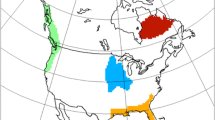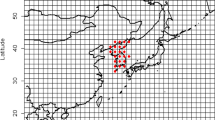Abstract
Recent winter seasons have evidenced that global warming does not exclude the occurrence of exceptionally cold and/or snowy episodes in the Northern mid-latitudes. The expected rarefaction of such events is likely to exacerbate both their societal and environmental impacts. This paper therefore aims to evaluate model uncertainties underlying the fate of wintertime cold extremes over Europe. Understanding why climate models (1) still show deficiencies in simulating present-day features and (2) differ in their responses under future scenarios for the twentyfirst century indeed constitutes a crucial challenge. Here we propose a weather-regime approach in order to separate the contributions of large-scale circulation and non-dynamical processes to biases or changes in the simulated mean and extreme temperatures. We illustrate our methodology from the wintertime occurrence of extremely cold days in idealized atmosphere-only experiments performed with two of the CMIP5 climate models (CNRM-CM5 and IPSL-CM5A-LR). First we find that most of the present-day temperature biases are due to systematic errors in non-dynamical processes, while the main features of the large-scale dynamics are well captured in such experiments driven by observed sea-surface temperatures, with the exception of a generalized underestimation of blocking episodes. Then we show that uncertainties associated with changes in large-scale circulation modulate the depletion in cold extremes under an idealized scenario for the late twentyfirst century. These preliminary results suggest that the original methodology proposed in this paper can be helpful for understanding spreads of larger model-ensembles when simulating the response of temperature extremes to climate change.










Similar content being viewed by others
References
Boé J, Terray L, Habets F, Martin E (2006) A simple statistical-dynamical downscaling scheme based on weather types and conditional resampling. J Geophys Res 111:D23106. doi:10.1029/2005JD006889
Cassou C (2008) Intraseasonal interaction between the Madden–Julian oscillation and the North Atlantic oscillation. Nature 455(7212):523–527. doi:10.1038/nature07286
Cassou C, Terray L, Phillips AS (2005) Tropical Atlantic influence on European heat waves. J Clim 18(15):2805–2811
Cattiaux J, Quesada B, Arakelian A, Codron F, Vautard R, Yiou P (2012) North-Atlantic dynamics and European temperature extremes in the IPSL model: sensitivity to atmospheric resolution. Clim Dyn (submitted)
Cattiaux J, Vautard R, Cassou C, Yiou P, Masson-Delmotte V, Codron F (2010a) Winter 2010 in Europe: a cold extreme in a warming climate. Geophys Res Lett 37:L20704. doi:10.1029/2010GL044613
Cattiaux J, Vautard R, Yiou P (2010b) North-Atlantic SST amplified recent wintertime European land temperature extremes and trends. Clim Dyn 36(11–12):2113–2128. doi:10.1007/s00382-010-0869-0
Cattiaux J, Yiou P, Vautard R (2011) Dynamics of future seasonal temperature trends and extremes in Europe: a multi-model analysis from CMIP3. Clim Dyn. Published online. doi:10.1007/s00382-011-1211-1
Corti S, Molteni F, Palmer TN (1999) Signature of recent climate change in frequencles of natural atmospheric circulation regimes. Nature 398(6730):799–802. doi:10.1038/19745
Déqué M, Marquet P, Jones RG (1998) Simulation of climate change over europe using a global variable resolution general circulation model. Clim Dyn 14(3):173–189. doi:10.1007/s003820050216
Deser C, Tomas R, Alexander M, Lawrence D (2010) The seasonal atmospheric response to projected arctic sea ice loss in the late twenty-first century. J Clim 23:333–351. doi:10.1175/2009JCLI3053.1
Douville H (2005) Limitations of time-slice experiments for predicting regional climate change over South Asia. Clim Dyn 24(4):373–391. doi:10.1007/s00382-004-0509-7
Driouech F, Déqué M, Sánchez-Gómez E (2010) Weather regimes—Moroccan precipitation link in a regional climate change simulation. Global Planet Change 72(1–2):1–10. doi:10.1016/j.gloplacha.2010.03.004
Dufresne JL et al (2012) Climate change projections using the IPSL-CM5 earth system model with an emphasis on changes between CMIP3 and CMIP5. Clim Dyn (submitted)
Franzke C, Woollings T, Martius O (2011) Persistent circulation regimes and preferred regime transitions in the North Atlantic. J Atmos Sci 68(12):2809–2825. doi:10.1175/JAS-D-11-046.1
Gillett NP, Zwiers FW, Weaver AJ, Stott PA (2003) Detection of human influence on sea-level pressure. Nature 422(6929):292–294. doi:10.1038/nature01487
Goubanova K, Li L, Yiou P, Codron F (2010) Relation between large-scale circulation and European winter temperature: does it hold under warmer climate? J Clim 3752–3760. doi:10.1175/2010JCLI3166.1
Haylock MR, Hofstra N, Klein Tank AMG, Klok EJ, Jones PD, New M (2008) A European daily high-resolution gridded data set of surface temperature and precipitation for 1950–2006. J Geophys Res 113:20119. doi:10.1029/2008JD10201
Hurrell JW, Kushnir Y, Ottersen G, Visbeck M (2003) The North Atlantic oscillation: climatic significance and environmental impact. American Geophysical Union, Washington, DC
Kanamitsu M, Ebisuzaki W, Woollen J, Yang SK, Hnilo JJ, Fiorino M, Potter GL (2002) NCEP-DOE AMIP-II reanalysis (R-2). Bull Am Meteorol Soc 83(11):1631–1643. ISSN 1520-0477
Kharin VV, Zwiers FW, Zhang X, Hegerl GC (2007) Changes in temperature and precipitation extremes in the IPCC ensemble of global coupled model simulations. J Clim 20(8):1419–1444
Kodra E, Steinhaeuser K, Ganguly AR (2011) Persisting cold extremes under 21st-century warming scenarios. Geophys Res Lett 38. doi:10.1029/2011GL047103
Lorenz EN (1969) Atmospheric predictability as revealed by naturally occurring analogues. J Atmos Sci 26(4):636–646
Menut L, Tripathi OP, Colette A, Vautard R, Flaounas E, Bessagnet B (2012) Evaluation of regional climate simulations for air quality modelling purposes. Clim Dyn. doi:10.1007/s00382-012-1345-9
Michelangeli PA, Vautard R, Legras B (1995) Weather regimes: recurrence and quasi stationarity. J Atmos Sci 52(8):1237–1256
Najac J, Boé J, Terray L (2009) A multi-model ensemble approach for assessment of climate change impact on surface winds in France. Clim Dyn 32:615–634. doi:10.&007/s00382-008-0440-4
Ouzeau G, Cattiaux J, Douville H, Ribes A, Saint-Martin D (2011) European cold winter of 2009/10: how unusual in the instrumental record and how reproducible in the Arpege-Climat model? Geophys Res Lett 38:L11706. doi:10.1029/2011GL047667
Palmer TN (1999) A nonlinear dynamical perspective on climate prediction. J Clim 12:575–591
Plaut G, Simonnet E (2001) Large-scale circulation classification, weather regimes, and local climate over France, the Alps and Western Europe. Clim Res 17(3):303–324
Rust HW, Vrac M, Lengaigne M, Sultan B (2010) Quantifying differences in circulation patterns based on probabilistic models. J Clim (in press). doi:10.1175/2010JCLI3432.1.
Sanchez-Gomez E, Terray L, Joly B (2008) Intra-seasonal atmospheric variability and extreme precipitation events in the European-Mediterranean region. Geophys Res Lett 35(15):L15708. doi:10.1029/2008GL034515
Scaife AA, Woollings T, Knight J, Martin G, Hinton T (2010) Atmospheric blocking and mean biases in climate models. J Clim 23:6143–6152
Stephenson DB, Pavan V, Collins M, Junge MM, Quadrelli R (2006) North Atlantic oscillation response to transient greenhouse gas forcing and the impact on European winter climate: a CMIP2 multi-model assessment. Clim Dyn 27(4):401–420. doi:10.1007/s00382-006-0140-x
Taylor KE, Stouffer RJ, Meehl GA (2007) A summary of the CMIP5 experiment design. World 4(December 2009):1–33
Thompson DWJ, Wallace JM (2001) Regional climate impacts of the Northern Hemisphere annular mode. Science 293(5527):85
van den Besselaar EJM, Klein Tank AMG, van der Schrier G (2010) Influence of circulation types on temperature extremes in Europe. Theoret Appl Climatol 99(3):431–439. doi:10.1007/s00704-009-0153-6
Vautard R (1990) Multiple weather regimes over the North Atlantic- analysis of precursors and successors. Mon Weather Rev 118(10):2056–81
Vautard R, Yiou P (2009) Control of recent European surface climate change by atmospheric flow. Geophys Res Lett 36(22):L22702. doi:10.1029/2009GL040480
Voldoire A, Sanchez-Gomez E, Salas y Melia D, Decharme B, Cassou C, Senesi S, Valcke S, Beau I, Alias A et al (2012) The CNRM-CM5.1 global climate model: description and basic evaluation. Clim Dyn. doi:10.1007/s00382-011-1259-y
Yiou P, Vautard R, Naveau P, Cassou C (2007) Inconsistency between atmospheric dynamics and temperatures during the exceptional 2006/2007 fall/winter and recent warming in Europe. Geophys Res Lett 34:L21808. doi:10.1029/2007GL031981
Acknowledgments
The authors thank the two anonymous reviewers for helpful comments, and S. Tyteca (CNRM-GAME) who prepared the data used in this study. NCEP2 data are provided by the NOAA/OAR/ESRL PSD, USA (http://www.esrl.noaa.gov/psd/). EOBS data are provided by the EU-FP6 project ENSEMBLES (http://ensembles-eu.metoffice.com) and uses data of the ECA&D project (http://eca.knmi.nl). The research leading to these results has received funding by the European Union, Seventh Framework Program (FP7/2007–2013) under grant agreement #244067.
Author information
Authors and Affiliations
Corresponding author
Additional information
This paper is a contribution to the special issue on the IPSL and CNRM global climate and Earth System Models, both developed in France and contributing to the 5th coupled model intercomparison project.
Rights and permissions
About this article
Cite this article
Cattiaux, J., Douville, H., Ribes, A. et al. Towards a better understanding of changes in wintertime cold extremes over Europe: a pilot study with CNRM and IPSL atmospheric models. Clim Dyn 40, 2433–2445 (2013). https://doi.org/10.1007/s00382-012-1436-7
Received:
Accepted:
Published:
Issue Date:
DOI: https://doi.org/10.1007/s00382-012-1436-7




